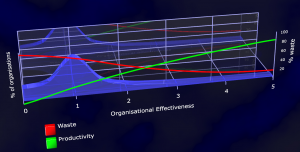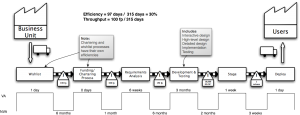Introducing Leftshifting
In the last few years there we have seen an ever increasing awareness about more streamlined practices for developing and delivering value through software and IT. At virtually every single conference you can find sessions on topics such as Continuous Delivery, Automatic Testing, Automatic Deployment, DevOps, Docker and Agile, and more often than not we are told that we have to shift left. All too often these practices are discussed as having some intrinsic value of their own, and every so often there is a session devoted to the intricacies of how to convince managers or developers, tester and operations that these practices should be introduced. But as for why we would want to introduce it, we are often assumed to somehow “know” that this is the right thing to do, and that it will make things better.
Interestingly, if we instead start by asking ourselves what kind of outcome we want to achieve by introducing these practices we may find that we are engaged in local optimisation in Lean speak, seen from a total systems perspective. That is, we optimise small parts but ignore the overall system, or indeed make the overall system worse. Using more words from Lean, we are not doing Systems Thinking. And when we start asking ourselves why we want to achieve these outcomes in the first place, we may very well discover that there are a whole slew of other practices, many unrelated to the technical work, that will have an even larger impact on the outcome.
It beautifully highlights why the introduction of a more effective software development, which seem to be the pet project of so many managers, have such limited effect on the overall capacity of a software organisation. In this example, reducing development and testing to zero by some magical means, would still yield no more than 15% improvement of Time To Market, with the corresponding 15% impact on the Cost of Delay. It is clear that creating a more effective organisation as a whole is needed. Also note that in this very typical process, the queue times amounts to more than 85% of the total process time.
You need feedback to learn
Does this mean that we advocate against these practices? Most emphatically NOT! We believe it is almost impossible to overstate the importance of introducing a high performing IT delivery, as it is by far the strongest enabler of a high performing business in general. One of the reasons it is such a strong enabler lies in the nature of learning; as it turns out, all learning is improved by good feedback, and the faster and more accurate feedback we get, the better we learn. And of course, learning is the basis for all improvements.
Virtually all of the practices that are now discussed and presented and mulled over so often, have one thing in common; they enable faster and more accurate feedback. Lining up all the activities required to develop a software based product along a time axis, we clearly see that these practices shift activities left. This is why you no doubt have heard said that we have to shift things left over and over in the last few years.
So what is the outcome we are looking for? Obviously, there are many different answers to this question, but what we have seen over the years is that most of them can conceptually be boiled down to the same thing; we want our business to become more effective. This inevitably leads to the question of how we define effective, and here we have borrowed from Bob Marshall‘s concept Rightshifting; “effectiveness is a business ability to achieve its goals”. As you can see, we were also inspired by the Rightshifting name when we created this space.
Shift left or shift right?
A quick refresher on the Rightshifting concept; Through his work with a huge number of knowledge businesses, together with the quantitive work of Steve McConnell and others, Bob Marshall found that if you were to index businesses’ effectiveness on a scale, the resulting curve would not be a classic standard deviation curve that peaks in the middle and have equal distribution to either side. Instead, the curve would be compressed towards the left of the axis with the the vast majority of business between 0.5 and 1.5 on a scale of about 5.
This is t he iconic picture of Rightshifting, and the thing to note here is where the vast majority of companies are in terms of waste. Yes, indeed, at 80% waste! 4 workdays out of 5 amounts to no value being added to the company! Since the vast majority of companies are at this stage, you should probably ask yourself, where is your company on this axis?
he iconic picture of Rightshifting, and the thing to note here is where the vast majority of companies are in terms of waste. Yes, indeed, at 80% waste! 4 workdays out of 5 amounts to no value being added to the company! Since the vast majority of companies are at this stage, you should probably ask yourself, where is your company on this axis?
Value is on this axis created by shifting right, and is at the heart of all the improvements that companies strive for. Since some of the most powerful tools at our disposal that enables a business to shift right along the effectiveness axis, is to shift left along the time axis for activities across the whole organisation. We will therefore use this space to investigate, discuss, advice and learn about how we can go about shifting all the activities in our businesses to the left. Shift left to shift right.

